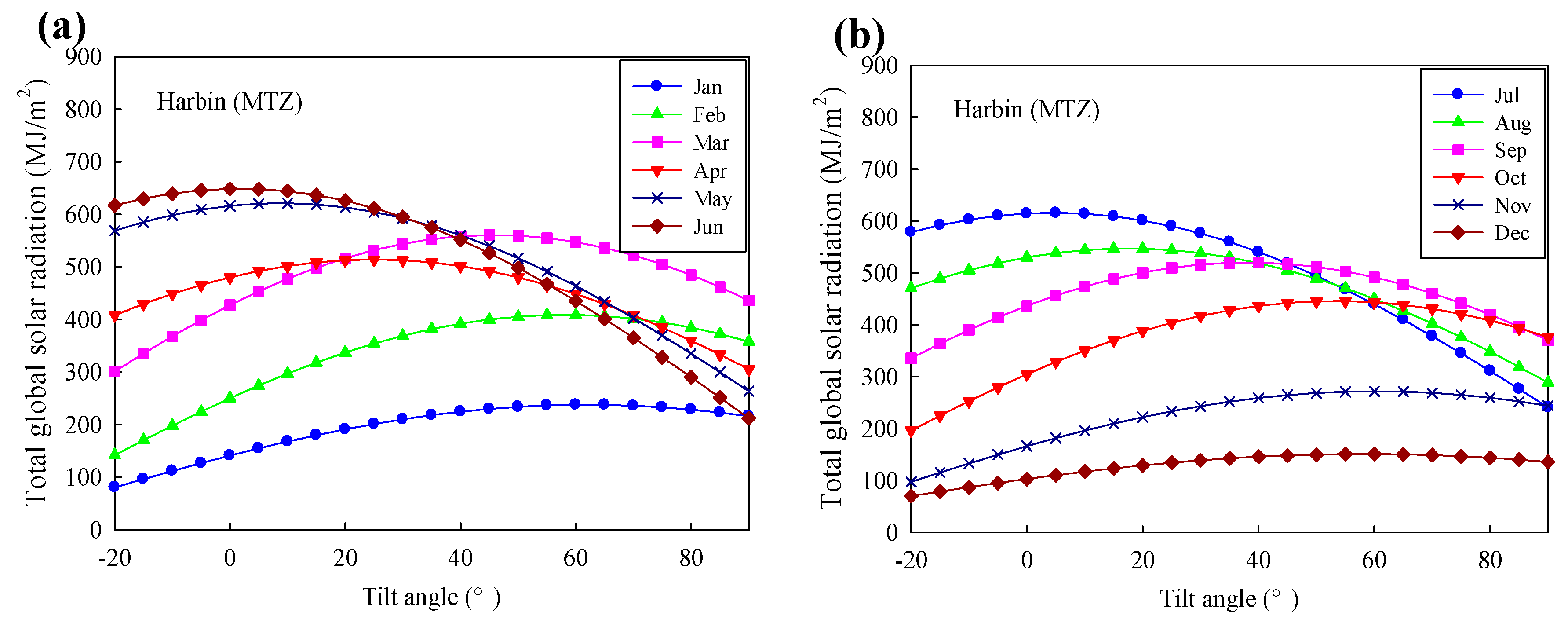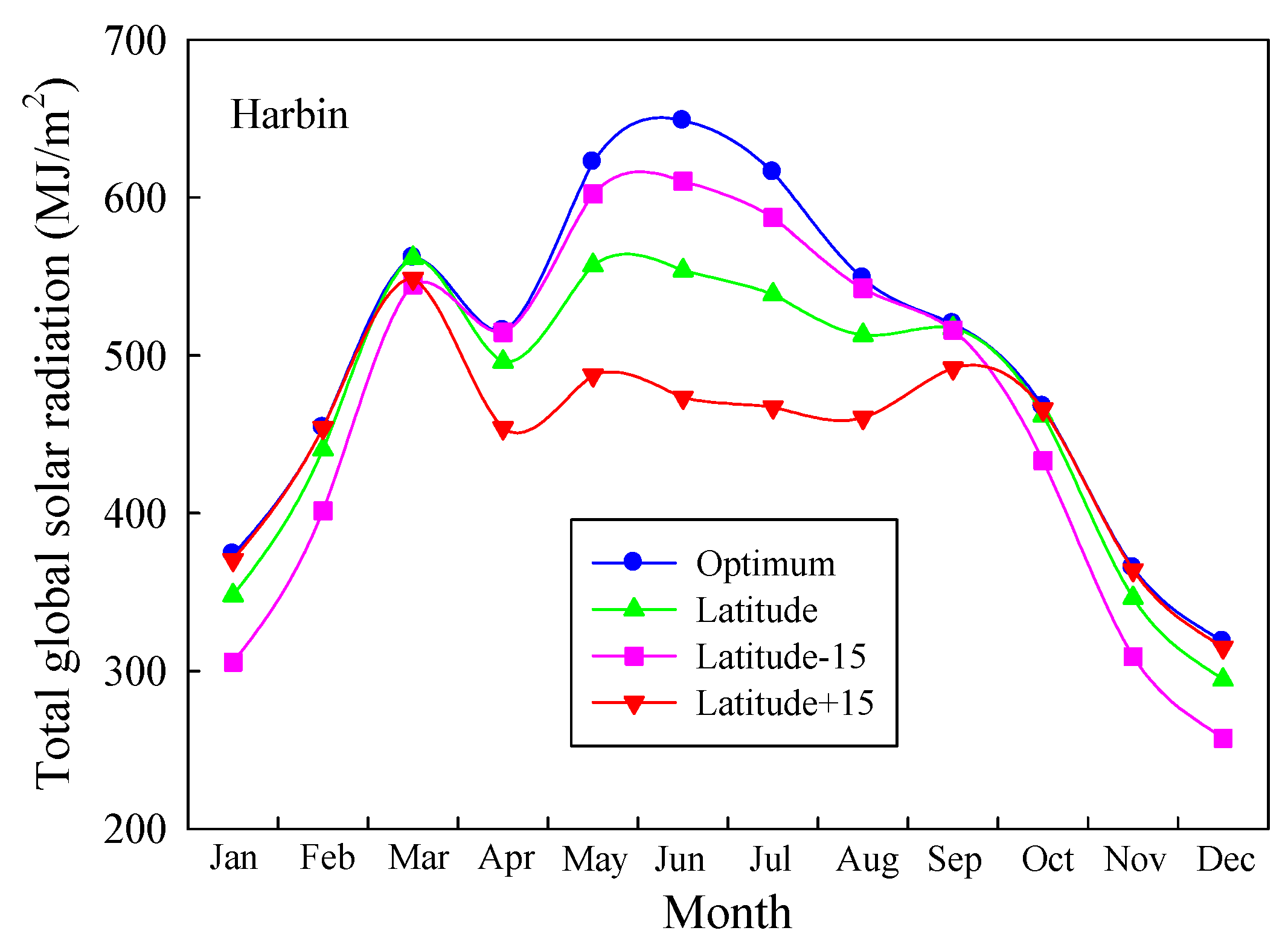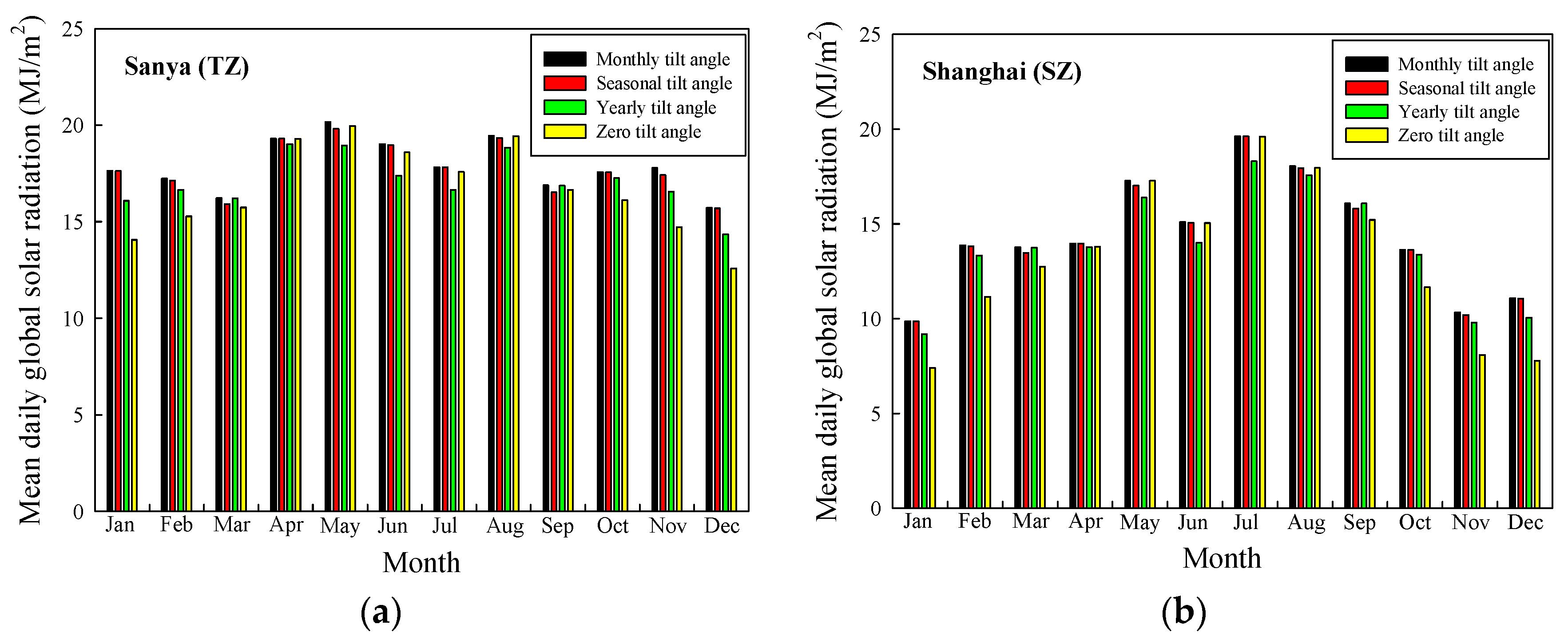1. Introduction
The performance of a photovoltaic panel is highly influenced by its tilt angle with the horizontal surface (with respect to the ground) because the tilt angle changes the solar radiation reaching the surface of the collector [
1,
2]. The best way to collect the maximum daily energy is to use a tracking system. A tracking system is a mechanical device that tracks the sun on its daily sweep across the sky. However, most photovoltaic (PV) modules are not suited for tracking, as they collect more sunlight and, therefore, produce more electricity if they are always oriented toward the sun. Trackers are expensive, need energy for their operation, and are not always applicable. Therefore, it is often practical to orient the solar collector at an optimum tilt angle and to correct the tilt from time to time.
Some investigators have made different recommendations for the optimum tilt, based on the latitude. Lunde [
3] and Garg [
4] obtained the optimum tilt angle, β
opt, φ ± 15°. Duffie and Beckman [
5] obtained β
opt, (φ ± 15°) ± 15°. Ibrahim [
6] showed the optimum tilt angles of summer months (φ − 21°) and winter months (φ + 13°) for Cyprus. Asl-Soleimani [
7] reported an annual optimum tilt angle of 30°, which is a bit lower than the local latitude (35.7°). Kalogirou [
8,
9] suggested the optimum tilt angle to be φ ± (10° − 15°). Gunerhan and Hepbasli [
10] determined the yearly optimum tilt angle for collectors in Izmir to be 35.8°, which is approximately the location’s latitude. Lave and Kleissl [
11] suggested yearly optimum tilt angles for several regions of the United States as β
opt, φ − (1° − 10°), by calculating the maximum incident solar radiation on the solar collector, where φ is the latitude of the location. Jafarkazemi [
12] concluded that the yearly optimum tilt angle (β
opt = 22°) is almost close to the latitude of Abu Dhabi (φ = 24.4°).
Some other optimization techniques have also been devoted to this problem in recent years, most of which treat the problem both qualitatively and quantitatively. Abdolzadeh and Mehrabian [
13], Bakirci [
14,
15], and Despotovic [
1] estimated the total (global) solar radiation intensity to obtain the optimum slope angle in a specific period for solar collectors. Kaldellis [
16,
17] and Pourgharibshahi [
18] verified the computational optimum tilt angles of a PV module by conducting experiments. The genetic algorithm method [
19,
20], particle swarm optimization [
21,
22], and the artificial neural network method [
23,
24] were also used to estimate the optimum tilt angle of PV modules.
The previous studies on the topic were carried out mostly in the foreign climate and geography. Yang and Lu [
25] developed a new mathematical model for calculating the optimum tilt angles and azimuth angles for building-integrated photovoltaic (BIPV) applications in Hong Kong on yearly, seasonal, and monthly bases. Sun [
26] investigated the combined energy effect produced by shading-type BIPV claddings and found that the optimum tilt angles of shading-type BIPV claddings at different orientations provide the most desirable energy-saving effect. Tang [
27] theoretically investigated the multi-reflection of radiation on both parabolic reflectors of a compound parabolic concentrator (CPC) with a one-sided flat absorber and its effect on energy-collection calculations. Generally, such research in China is still limited. Thus, the present study aims to develop an analytical procedure to obtain formulae which determine β
opt for any climatic type in China.
The main objective of this study is to determine the optimum tilt angle of photovoltaic panels on the basis of maximizing the global solar radiation reaching the collector surface on a monthly, seasonal, and yearly basis and to develop general correlations for estimating the monthly optimum tilt angles at six stations of different climatic zones. The effect of the Earth’s reflection on the global solar radiation for a solar collector inclined at the optimum slope angle is investigated. The calculations are based on the data of air-dry bulb temperature, relative humidity, wind velocity, and global solar radiation from China’s meteorological stations. These data are collected for a period of 16 years (1994–2009).
4. Estimation of Solar Radiation on the Inclined Surface
The monthly mean daily global solar radiation data on the inclined surface are important and useful for solar energy applications. However, daily global solar radiation data on a tilted surface are generally unmeasured and unavailable. In this paper, a simple and universal method is proposed to estimate the monthly mean daily global solar radiation on tilted surfaces facing directly towards the equator. Moreover, the monthly mean daily global radiation on a tilted surface (
HT) can be estimated by the following relation:
where
R is the ratio of the monthly average daily global radiation on a tilted surface to that on a horizontal surface. The ratio
R, developed by Liu and Jordan [
15,
40], can be defined as:
where
H and
Hd are the monthly average daily global and diffuse solar radiation on a horizontal surface, respectively;
Rb is the ratio of the average daily beam radiation for each calendar month on an inclined surface to that on a horizontal surface; ρ (=0.2) is the ground reflection coefficient; β is the tilt angle of photovoltaic panels. The monthly average daily global solar radiation data produced from the TMY data, proposed in our earlier research [
39], are applied in the present study.
The diffuse component recommended in the previous studies [
41] is adopted in this work. Accordingly, the monthly average daily diffuse solar radiation data is calculated according to:
where
KT is the clearness index of the sky.
KT can be obtained using the following formula:
Here,
H0 is the monthly mean daily extraterrestrial radiation on a horizontal surface [
42], which is computed by
where
I0 is the solar constant (1367 W/m
2);
n is the number of daily readings of the month and is counted from 1 January (1–365);
j is the geographic latitude of the location; ω
S is the sunrise (or sunset) angle on a horizontal surface; δ is the declination of the sun. In this paper, the monthly representative day and its corresponding declination are applied and shown in
Table 4.
In the present study, the photovoltaic panels are all in the Northern Hemisphere, and the factor
Rb suggested by Liu and Jordan [
40] can be written as
where ω
S′ is the sunrise (or sunset) hour angle for the inclined surface.
In this paper, Equations (5)–(10) are applied to calculate the monthly mean daily global solar radiation on the south-facing inclined surface for six different stations in China. The tilt angle is changed from −20° to 90° in steps of 0.1° and the corresponding value of maximum global solar radiation for a specific period is defined as the optimal tilt angle.
5. Results and Discussions
By applying the above procedure and the data from the six stations listed in
Table 1, the monthly, seasonal, and yearly optimum tilt angles and total radiation on the inclined panel are calculated using Equations (5)–(10).
Table 5 shows the monthly optimum tilt angle of the six stations. The monthly optimum angles range from −14.7° (June) to 43.3° (December) for Sanya, from −5.2° (June) to 53.2° (December) for Shanghai, from −3.9° (June) to 57° (December) for Zhengzhou, from 2.6° (June) to 69.4° (December) for Harbin, from 9.3° (June) to 78.4° (December) for Mohe, and from −8.5° (June) to 60.5° (December) for Lhasa. Obviously, negative values appear in the determination of optimum tilt angles, such as for June in Lhasa. A negative value of the optimum tilt angle indicates that the photovoltaic panels face North.
Taking Harbin as an example, the calculated data generated by the above method are given in
Table 6, including the monthly mean daily extraterrestrial radiation on a horizontal surface (
H0), the clearness index of the sky (
KT), diffuse solar radiation on a horizontal surface (
Hd), the optimum tilt angle (β
opt), the monthly mean daily global solar radiation on an optimum tilt surface (
HT), and the comparison of
H and
HT. Clearly, the maximum and minimum
HT values occur in June and December, respectively. Meanwhile, it can be seen from
Table 6 (the last column) that the efficiency of the solar panel at the monthly optimum tilt angle is obviously increased compared to that with a horizontal surface. Within a year, the comparison of
H and
HT has a maximum value of 120.95% (December).
The monthly total global solar radiation, when the tilt angle changes from −20° to 90°, is given in
Figure 1. The figure indicates that for each month, there is a great difference among the monthly total global solar radiation values due to different tilt angles. In addition, the maximum value of the monthly total global solar radiation corresponds to a specific tilt angle, i.e., the monthly optimum tilt angle. For October, the maximum value of the monthly total global solar radiation for Harbin (MTZ) is 467.48 MJ/m
2, corresponding to 54.8° (the monthly optimum tilt angle).
Figure 2 shows the total global solar radiation for the determined tilt angles when the solar collector is tilted at the monthly optimum tilt angle, the latitude, and the latitude ±15. Results reveal that the optimum angles give higher values of the optimum angle for the whole year as compared with the latitude and the latitude ±15. It is noted that in March, there is little difference in the radiation values determined by these methods.
The seasonal and yearly optimum tilt angles for six stations in different climatic zones are also given in
Table 5. The seasonal optimum tilt angles are the mean of the monthly optimum tilt angles in a season, while the yearly optimum tilt angles are the average of the monthly optimum tilt angles in a year.
Figure 3 shows the mean daily global solar radiation collected fixed at zero and at optimum monthly, optimum seasonal, and optimum yearly tilt angles for each month at six stations. As shown in the figure, the mean daily global solar radiation on a solar collector fixed at the monthly optimum tilt angle shows a significant increase compared to the horizontal and yearly collectors. Moreover, the mean daily global solar radiation at the optimum tilt angle is generally more than that for the horizontal collector, especially in the spring and winter at the Zhengzhou (WTZ), Harbin (MTZ), Mohe (CTZ), and Lhasa (TPZ) stations.
Additionally, the correlation equations of the optimum tilt angle (β
opt) based on the declination factor (δ) are generated and investigated for six stations in different climatic zones of China. These correlation equations are given below, where
a,
b,
c, d are the regression coefficients of δ from degree 0 (constant term) to degree 3, respectively.
The accuracy and suitability of the models is checked by the mean absolute bias error (MABE), the root mean square error (RMSE) and the correlation coefficient (R) [
43,
44,
45]. The values of β
opt calculated from the above equations obtained for each station are presented in
Table 7. The regression coefficients and the statistical errors of the proposed equations for the six stations in different climates of China are shown in
Table 8. The MABE lies between 0.2221 MJ/m
2 and 2.5413 MJ/m
2, the maximum of RMSE is 2.8892 MJ/m
2 and the minimum of RMSE is 0.2697 MJ/m
2. Also, the mean value of the correlation coefficients R for all the six stations is as high as 0.9983. The results indicate that the monthly optimum tilt angle data obtained from the proposed models are sufficiently reliable. According to the results of the statistical indicators, Equation (13) generally has the best performance when compared with Equations (11) and (12).
6. Conclusions
The optimum tilt angle plays an important role in enhancing the energy collection of solar collectors. In the present research, the monthly, seasonal, and yearly optimum tilt angles for solar collectors in six different climatic zones of China are computed using the measured weather data from China’s meteorological stations over a 16-year period from 1994 to 2009, including air-dry bulb temperature, relative humidity, wind velocity, and global solar radiation data. The results show that the calculated maximum and minimum monthly optimum tilt angles are −9.7° (June, Sanya) and 78.4° (December, Mohe) at six typical stations. The monthly optimum tilt angles, with Harbin as an example, are studied and analyzed. The yearly average optimum tilt angles for a south-facing solar collector are 15°, 24.2°, 27.4°, 39.0°, 47.1°, and 27.5° in Sanya, Shanghai, Zhengzhou, Harbin, Mohe, and Lhasa, respectively. We have found that the yearly average of the optimum tilt angle is equal to the latitude of the site. This, in general, is in agreement with the results of many other researchers [
13,
46]. It is observed that six cities have the highest gain in solar radiation intensity when a collector is fixed at the monthly optimum tilt angle. It can be concluded that a yearly average fixed tilt angle can be used in many general applications in order to keep the manufacturing and installation costs of collectors low. For higher efficiency, the collector should be designed such that the tilt angle can easily be changed at least on a seasonal basis, if not monthly. Moreover, the general correlation equations for estimating the monthly optimum angles are developed for six stations at different climatic zones. The three proposed models are investigated using statistical indicators (including MABE, RMSE and R). The results of the statistical analysis indicate that the models in Equations (11)–(13) obtained in the paper can be used to estimate the optimum tilt angle with a high accuracy in China. These correlations can be used elsewhere with similar climatic conditions.
It is expected that the monthly, seasonal, and yearly optimum tilt angles and the general correlation equations giving optimum tilt angles generated in this paper will exert positive effects on pertinent energy-related scientific research and engineering applications in China. Future research will focus on optimum tilt angles and the general correlations on a larger regional scale; we hope to report on such works in the near future.











